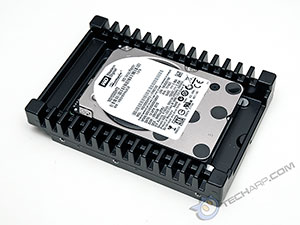Introduction
We recently reviewed both the latest Western Digital VelociRaptor and the Intel 520 Series Solid State Drive, and it got us thinking about a direct comparison. Both drives may be fundamentally different in the way they work but they actually target the same market - the hardware performance enthusiast!
With graphics cards and processors so powerful these days and DDR3 SDRAM so cheap, the only thing holding back a system is often the storage subsystem. Hence, there is an increase emphasis on the performance of the hard disk drive, or its rival, the solid state drive.
Many have said that the days of the hard disk drive is waning, and the age of the solid state drive has begun. But is the hard disk drive really on the way out? That is what this small comparison is about.
We will take a look at the performance of two of the fastest SATA hard disk drives, the Western Digital VelociRaptors; and pit them against the performance of two popular solid state drives. First, let's take a look at the competing drives...
Western Digital VelociRaptors
 |
Western Digital may be marketing their new VelociRaptor family of high-speed hard drives as enterprise-class hard drives but they are also very popular with hardware enthusiasts who just cannot resist their 10,000 RPM spindle speed. Everything just seems much faster when you have a hard disk drive that spins at such a high speed. To cater to this exclusive group of enthusiasts, Western Digital first introduced the Raptor and Raptor X hard disk drives in the 3.5" form factor with capacities of 36 GB to 150 GB.
These Raptors evolved into the Western Digital VelociRaptor hard disk drives in the much smaller 2.5" form factor. The VelociRaptor drives boast not only a 10,000 RPM spindle speed in a small package, but also high density platters which allow them to supersede the older Raptor drives, which use larger but lower density platters, in both performance and storage capacity.
Western Digital recently launched their third-generation VelociRaptor hard disk drive, which continues to be the world's only 10,000 RPM hard disk drive with a SATA interface. The third-generation VelociRaptor improved on its predecessor by using Advanced Format Technology (AFT) and higher-density platters to deliver not only 1 TB of storage capacity but also a sustained throughput of 200 MB/s. Here are the key features common to all Western Digital VelociRaptor models :
Ultra fast - Designed around a 10,000 RPM spin speed and the SATA 6 Gb/s interface.
Rock-solid reliability - With 1.4 million hours MTBF, these drives have the highest available reliability rating on a high capacity SATA drive.
IcePack™ mounting frame - The 2.5-inch hard drive is enclosed in a backplane-ready 3.5-inch mounting frame with a built-in heat sink that keeps this powerful little drive extra cool when installed in high-performance desktop chassis.
NoTouch™ ramp load technology - The recording head never touches the disk media ensuring significantly less wear to the recording head and media as well as better drive protection in transit.
Rotary Acceleration Feed Forward (RAFF™) - Optimizes operation and performance when the drives are used in
vibration-prone, multi-drive chassis.
For the purpose of this comparison, we will be selecting both the third-generation 1 TB VelociRaptor (WD1000DHTZ) and the second-generation 600 GB VelociRaptor (WD6000HLHX). The main reason why we chose to compare the older VelociRaptor model is because it is the last VelociRaptor to use the old 512-byte sector. Although the latest VelociRaptor features the new Advanced Format Technology, which allows for higher areal density and transfer rates, the emulation mode used greatly impacted its seek times. So the older 600 GB VelociRaptor is still much faster at random seeks.
Intel Solid State Drives
Intel is one of the world's leading manufacturers of solid state drives (SSDs) and NAND flash memory chips - the very foundation of solid state drives and USB flash drives. In fact, they offer one of the widest range of solid state drives in the market :
- Intel Solid-State Drive 910 Series
- PCIe-based high-performance storage to accelerate data center servers and cloud storage.
- Intel Solid-State Drive 710 Series
- High-endurance 2.5" SSDs for data servers
- Intel Solid-State Drive 520 and 510 Series
- High-performance 2.5" SSDs for desktops and notebooks
- Intel Solid-State Drive 330, 320 Series
- Mainstream 2.5" SSDs for desktops and notebooks
- Intel Solid-State Drive 313 and 311 Series
- Value-grade 2.5" SSDs for desktops and notebooks
- Intel Solid-State Drive 310 Series
- Value-grade mSATA SSDs for netbooks
The 240 GB Intel 520 Series SSD is one of the most popular choices because it not only offers the best performance characteristics in the Intel 520 family but also a large amount of storage capacity at a relatively affordable price. It is also one of the many solid state drives based on the popular SandForce SF-2200 controller, and have similar performance characteristics. Therefore, we are including it as both a popular choice as well as a stand-in for the other SF-2200-based solid state drives.
We are also throwing in the previous generation (34 nm) solid state drive because it was a popular choice as well, and will serve as a good rival to the 600 GB VelociRaptor above.
Support Tech ARP!
If you like our work, you can help support out work by visiting our sponsors, participate in the Tech ARP Forums, or even donate to our fund. Any help you can render is greatly appreciated!
Page |
Topic |
|
1 |
• VelociRaptors Vs. Solid State Drives |
|
2 |
• Testing The HDDs & SSDs |
|
3 |
||
4 |
||
5 |
||
6 |
||
7 |
||
8 |
||
9 |







 Add to Reddit
Add to Reddit

